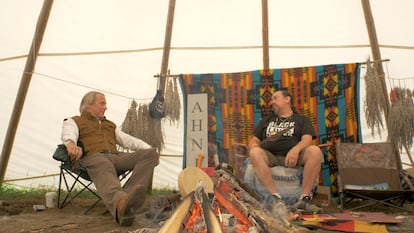The Indigenous peoples of Canada, who represent nearly 5% of the total population of the North American country, have had a national television network since 1999. In fact, it’s the first of its kind in the world. The main function of APTN — the Aboriginal Peoples Television Network — is to broadcast content about these communities, made by its own members, to a diverse audience.
Relations between Canada and its Indigenous peoples have long been painful, due to a series of decisions taken in Ottawa. The effects of Canadian colonialism — with a legacy of racism, discrimination, condescension and dispossession — have had a harmful impact on entire generations of Indigenous groups.
For the last few decades, the federal government has attempted to improve this situation. One of the pillars of this strategy has to do with greater support to the tribes, so that they can preserve and disseminate the historical and cultural wealth of their peoples. In this respect, APTN receives significant funding from federal coffers.
The channel took its first steps in 1992, when it began operating in a strip that stretched from the territory of the Yukon to the province of Newfoundland and Labrador. However, after substantial pressure from Indigenous leaders and civil society organizations, the regulatory body granted APTN a license in February of 1999 for national coverage. The channel began broadcasting throughout the country on September 1, 1999. Its headquarters are located in Winnipeg, the capital and largest city of the province of Manitoba, but it has studios in dozens of cities. APTN’s programs reach eight million homes.
 One of the sports programs on the channel, in an image provided by APTN.
One of the sports programs on the channel, in an image provided by APTN.
According to its most recent report, 70% of the network’s employees belong to Indigenous groups, 55% of its content is produced in English, 15% in French and the rest in 16 of the country’s major Indigenous languages (Cree, Micmac, Ojibway, Inuktitut, among others). To mark APTN’s 25th anniversary of national broadcasting, a major change was announced last May: there will soon be one channel with content in English and French, while a second will be reserved solely for programming in Indigenous languages.
Monika Ille, CEO of the network, said on the day of the announcement: “This is a crucial moment in the history of Indigenous peoples. APTN has a fundamental role to play in the protection and revitalization of our languages.”
As part of its modernization strategies, in recent years the network has allocated considerable funding to stream its programs online. As a result, a wide range of these programs are available without restrictions, even outside of Canada. APTN has also signed collaboration agreements with Indigenous television projects from other parts of the world to share series, documentaries and other content. While 80% of its programming is Canadian, the remaining 20% comes from the United States, Australia, New Zealand, and Latin America.
 A still from the documentary series ‘Going Native,’ hosted by Drew Hayden Taylor (left). Image courtesy of APTN.
A still from the documentary series ‘Going Native,’ hosted by Drew Hayden Taylor (left). Image courtesy of APTN.
The channel offers a diverse range of programming, both in terms of themes and age groups. Some of its children’s, comedy and cooking programs have enjoyed a loyal audience for several decades. The skills of its Indigenous documentary makers are particularly noteworthy in this offering. A wide range of programs enables viewers to discover the cultural richness of Canada’s Indigenous peoples, whether through the paintings by Norval Morrisseau, the writings of Natasha Kanapé Fontaine, or the theater groups in British Columbia, which adapt myths and legends. APTN’s nature documentaries also enjoy a strong reputation.
Beyond culture, APTN has a strong news content team, with a national newscast and regional editions. It’s worth highlighting the renowned work of its investigative journalists, mainly those who are part of APTN Investigates, a program that focuses on difficult issues that affect Indigenous communities in Canada. One of them has to do with the impact of the residential schools for Aboriginal children that operated in Canada from 1883 to 1996. The on-screen testimonies of former students of these centers — who were taken away from their families and institutionalized against their will — are chilling.
For decades, APTN journalists have denounced the problems surrounding access to clean drinking water in some of the country’s reserves. They’ve also focused on the high rates of violence faced by many Indigenous women and girls. They have also uncovered — together with the public broadcaster, CBC — various cases of so-called “pretendians,” or people who falsely claim to be Indigenous in order to have access to a series of advantages intended for members of the tribes (including scholarships, government grants, tax benefits, and awards). Three of the most high-profile cases have been writer Joseph Boyden, filmmaker Michelle Latimer, and singer-songwriter Buffy Sainte-Mairie.
 Frank Quitish, in an image from the program ‘On the Front Line,’ from the Canadian channel APTN. Photo provided by the channel.
Frank Quitish, in an image from the program ‘On the Front Line,’ from the Canadian channel APTN. Photo provided by the channel.
The Indigenous network also offers fictional content, either self-produced or co-produced. One of APTN’s biggest hits has been Mohawk Girls, a kind of Sex and the City set on a reservation near Montreal. In addition to the love lives and sexual adventures of the four protagonists, the series, which was broadcast from 2014 until 2017, is self-critical of various behaviors in these communities, such as the importance given to “blood purity.”
Tracey Deer, creator of the show, told The New York Times: “Some Indigenous viewers have been upset by the appearance of these themes, but most appreciate that they’re addressed in a humorous way.” Mohawk Girls was also successfully broadcast in Australia. It’s also part of the catalogue of shows available on Air Canada flights.
Another APTN show that has garnered acclaim inside and outside Canada is Little Bird. Released in 2023, the six-episode miniseries tells the story of how an Indigenous woman who was adopted by a Jewish family tries to reconnect with her biological family and her cultural roots. The story is based on a government policy during the 1960s that allowed thousands of Indigenous children to be adopted by couples who didn’t belong to their communities. Little Bird is also available on the Crave platform and on PBS.
Sign up for our weekly newsletterto get more English-language news coverage from EL PAÍS USA Edition
Source link : http://www.bing.com/news/apiclick.aspx?ref=FexRss&aid=&tid=66c176b906254df29450bd870d868b90&url=https%3A%2F%2Fenglish.elpais.com%2Fculture%2F2024-08-18%2Faptn-the-channel-for-canadas-indigenous-communities.html&c=13760313260106243869&mkt=en-us
Author :
Publish date : 2024-08-17 17:05:00
Copyright for syndicated content belongs to the linked Source.







